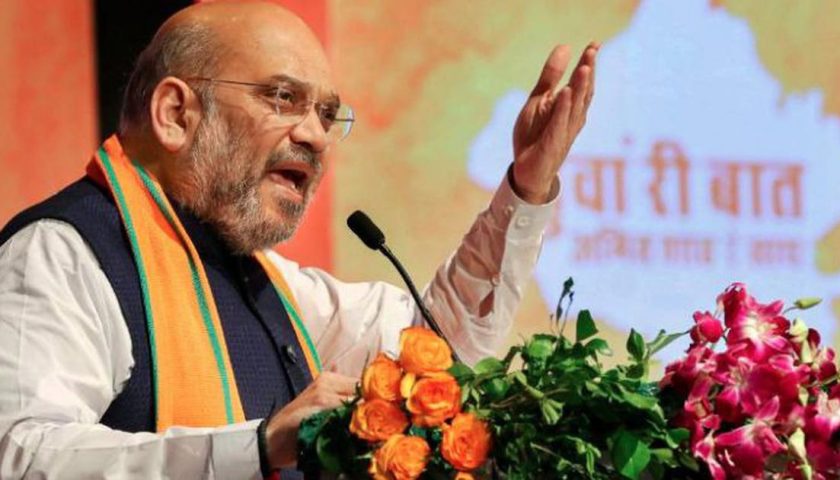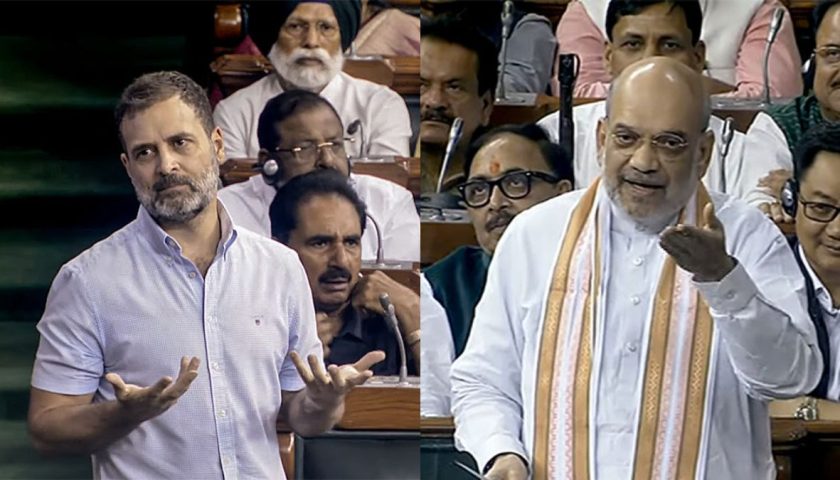If India is today a Hindu nation, it is also a tinderbox in which the self is defined by the perpetual hatred of others.
Uday Chandra
On August 5, India’s Prime Minister Narendra Modi laid the foundation stone for a Hindu temple in the northern city of Ayodhya. This fulfilled the orders of India’s Supreme Court, which last November awarded a victory to those who have long been campaigning to build a temple there, in place of a Mughal-era mosque that was demolished by a right-wing Hindu mob in 1992. The speculation that the mosque was built on the ruins of an ancient temple marking the mythological birthplace of the epic hero Ram remains unproven.
The groundbreaking ceremony for the temple was set on that particular date to commemorate the altering of the country’s constitution to justify a shift from indirect to direct colonialism in the disputed Muslim-majority region of Jammu and Kashmir exactly a year ago.
The temple construction in Ayodhya, just like the constitutional amendment that revoked the Indian-administered Kashmir’s limited autonomy, is a calculated move by the Modi government to consolidate the new majoritarian polity in India.
Today, we are witnessing the final stages of the project to remake India into a Hindu nation, but little is being said about the fabulous falsehoods and cunning sleights of hand that this ambitious project was built upon.
Colonial origins
The word “Hindu” is a Persianate derivative of “Sindhu”, Sanskrit for the Indus River. Only during India’s colonial encounter in the 19th century did “Hindu” become an ascriptive label for a wide range of practices and ideas across South Asia that do not fall within the three world religions labelled “Islam”, “Christianity”, and “Buddhism”. But this term defined by negation did not mean much to those located within a mosaic of Indic ritual and philosophical traditions that lacked a holy book based on divine revelation.
Scholars have attributed the invention of “Hinduism” as much to men from dominant castes who sought to reform and remake a colonised society as to colonial missionaries. These 19th-century reformers sought to go back to ancient texts such as the Vedas or the Upanishads to propose a de-ritualised, quasi-monotheistic creed for a modern India. Such a move mimicked the textualist methods of the Protestant Reformation, and the then fashionable European efforts to appropriate ancient Sanskrit spiritual texts to construct an “Aryan” race identity.
The reformers were answering British criticisms of Indic polytheisms as “beastly” and “superstitious”. They enthusiastically embraced the colonial view of Muslims being wholly separate from Hindus, ignoring the accommodations and intermixing over centuries that had produced shared ritual, intellectual, sartorial, culinary, and musical traditions between the two groups.
As the reforming Hindu men worked to draw sharp lines between “Hindus” and “Muslims”, the newly emerging print media became their accomplice. The adoption of the Nagri script by reformist groups such as the Arya Samaj contrasted with the shared orality of a public sphere defined by the Hindustani language. Devanagari, the divine Nagri as it became known, also started to be used alongside Urdu and English in the new world of print technology, helping reformists in their efforts to create a distinct Hindu identity.
Then, as it is now, the chief obstacle to transforming India into a Hindu nation was the caste system which divided society into strict hierarchical groups. To accommodate the lower orders of society, the conservatism of the Brahmins, the traditional priestly class who sit atop the rigid caste hierarchy, had to be diluted. But to de-brahminise Hinduism would have dissolved the abstract new polity of the reformers’ imagination into a melange of lived traditions across the localities and regions of India.
From the colonial to the post-colonial
A century ago, the arrival of Mohandas Karamchand Gandhi on the political scene provided a solution to the reformers’ dilemma. Gandhi claimed that his religion as much as that of most “Hindus” was Sanatan Dharma, the perennial faith, not the new-fangled textual abstractions put forward by the reformers. Caste, he argued, was a necessary evil in the subcontinental life. It could neither be wished away nor reformed out of existence.
A hierarchical society, suggested Gandhi, could learn to be humane and to avoid excesses. Vertical hierarchies could be held together by horizontal alliances between those of similar rank, whether at the top or the bottom. Hindu and Muslim elites could be tied together by common interests of peace and prosperity just as the Hindu and Muslim masses were held together by shared solidarities of class and occupation.
The Gandhian solution to the problem was largely embraced by the anti-colonial movement in India led by the Congress party. Muhammad Ali Jinnah, who led the campaign for a separate state of Pakistan, had also endorsed the Gandhian solution in British India, but he was prescient to realise that its appeal would wane steadily with modernisation once the fortunes of Indian Muslims were placed at the mercy of a consolidated Hindu majority.
The principal critics of the Gandhian solution – anti-caste thinkers such as Bhimrao Ramji Ambedkar and theorists of Hindu nationalism such as Vinayak Damodar Savarkar – preferred a modern and egalitarian solution to the problem faced by the 19th-century reformers. Both Ambedkar and Savarkar sought equality in politics and society, not hierarchy. Yet Ambedkar reposed his faith in new constitutional liberalism derived from the French and American constitutions. Savarkar endeavoured, by contrast, to create a new political religion, called Hindutva (Hindu-ness) to unify India along the lines of the Italian Risorgimento.
In the early decades after independence, the Congress governments balanced the hierarchical accommodationist view proposed by Gandhi with modernism rooted in equal citizenship regardless of caste or faith. This was an era in which all were equal citizens of India, even Kashmiris, even if long-standing social hierarchies remained intact. Elite Muslims and Christians featured prominently in public life just as they had done in the colonial era.
With economic liberalisation and neoliberal globalisation since 1980, the old hierarchies have been shaken up. The myriad castes that constitute Indian society have been shattered into infinitesimal fragments, which have given rise to fractalised identities vying for equality at the expense of each other. The centrifugal force in pursuit of equality in public life led to dissensus, not a new national consensus.
In response, the Bharatiya Janata Party (BJP), particularly under Modi, has revived Savarkar’s vision of Hindutva as a political religion, albeit in a distinctly populist vein. One’s religious beliefs and practices matter less in Hindutva than an absolute commitment to a Hindu “rashtra” or polity. The fractalised selves of post-liberalisation have been brought together by the centripetal force of electoral rituals, digital media, and a new Hindu state, all of which offer an insurgent sense of equality.
Political Hinduism
Rhetorically, the Hindu rashtra is opposed to discrimination based on caste for political Hindus. Modi’s own humble origins and his rise to power are presented as clinching evidence of a new egalitarian modernism. But, in practice, Hindutva is willing to accommodate the everyday oppressions that define Indian society. In effect, some are more equal than others. Conservatism is now couched increasingly in the modern semantics of class (“rich” and “poor”) rather than in traditional caste terms.
Those who do not identify as political Hindus – Muslims, Christians, leftists, anti-caste activists – are the new objects of discrimination and exclusion. In principle, if individuals from these groups embrace Hindutva, they, too, would be considered political Hindus. The lines are, in sum, permeable, and everything is negotiable in the new Hindu polity.
At least for now, the Hindu rashtra is a highly personalised regime, almost a cult, in which Modi is the state and countenances no opposition, not even from the judiciary or the central bank. Civil society, the media and academia are treated with suspicion because they breed dissent. Through a mix of carrot and stick, the media have been compelled to voice propaganda, and prominent journalists, activists, and academics have been arrested or bullied into silence.
The electoral system is now dominated by a single political party committed to Hindutva, namely, the BJP. Other parties, including the Congress, have been compelled now to speak the language of Hindutva and acquiesce in the new political religion.
Oddly enough, we know little about the ritual lives and personal beliefs of Modi or his predecessors. The new political religion of Hindutva seems to define itself almost entirely by negation vis-a-vis the Muslim (or Christian) Other. Other Indic traditions defined traditionally in opposition to Hinduism – Buddhism, Jainism, Sikhism – are simply seen as Hindu offshoots.
The territorial boundaries of the nation are sacralised in Hindu India. Nowhere is this more apparent than in Kashmir, where long-standing legal arrangements have been forcibly undone. These violent rituals of integration are meant to build communitas among political Hindus, the true citizens of the new polity. Settler colonialism is now expected to complete this process of national integration.
Kashmiri Muslims as colonial subjects stand metonymically for all Indian Muslims. The project of subjugating religious minorities is now regarded as a sacred duty in the service of the nation.
By contrast, ethnic minorities in northeast India are encouraged to negotiate the terms of their political assimilation within Hindu India. In response to activists’ claims about indigenity in these regions bordering China and Myanmar, the BJP now claims that all Indigenous peoples of India are Hindu, and all Hindus are, by definition, indigenous to India.
Hindutva is, undoubtedly, an abstract political religion, stripped of contextual or historical depth. This is precisely what the colonial-era reformers and Savarkar had dreamed of: an all-India Hinduism that reins in the problem of caste via the dazzling dream of equal citizenship. Not only is a Hindu rashtra now a reality, but the Muslim Other has been subjugated within it. The inauguration of the Ram temple in Ayodhya, much like the colonisation of Kashmir, has accomplished both tasks in the highly symbolic and theatrical world of Hindutva.
If India is today a Hindu nation, it is also a tinderbox in which the self is defined by the perpetual hatred of others. Whenever India’s youth tire of this majoritarian politics of hate, they will reflect on the paths not taken to make their country a prosperous, equitable, and decent.
Sourcce: https://www.aljazeera.com/indepth/opinion/making-hindu-india-200820104806024.html?fbclid=IwAR0616gXzhRHUJm44lLn7PlSPHJ6RodSLI51Z0f3Huk1Ik7yQXNBo8JGpY4






